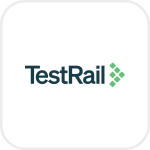
- Overview
- Configuration
Test Rail
Orchestrate your entire QA process in one centralized platform
TestRail is a web-based test case management tool that helps teams to organize their QA testing efforts, improving project outcomes. Integrating ADManager Plus with TestRail simplifies user creation, enforces role-based access control, and automates user management and offboarding, leading to a more secure environment. Additionally, it empowers IT teams to enforce granular access controls within TestRail repositories, to ensure users have the required permissions and access to resources to carry out their responsibilities without risking privilege creep.
Automate user onboarding
When a new employee is added to AD, their TestRail account can be automatically created, ensuring immediate access to necessary test projects and tools. This allows new hires to start contributing without delay, improving productivity and reducing the administrative burden on IT staff.
Reduce security risks
Automatically adjust or revoke permissions based on role changes in Test Rail, ensuring that only authorized users have access to sensitive test data and infrastructure using REST API support.
How to configure TestRail integration in ADManager Plus
Pre-requisites
- TestRail uses basic authentication credentials to authorize API request
- Authentication credentials required: Username, password, and subdomain
Privileges
- To import users (Inbound action): Ensure the account used for authorization has permission to read all user accounts.
- To perform any action or query in TestRail (Outbound Action): Ensure the account used for authorization has permission to perform the desired action.
Authorization configuration
- Log in to ADManager Plus and navigate to the Automation tab.
- In the left pane, under Configuration, click Application Integrations.
- Under Enterprise Applications, click TestRail.
- Toggle the Enable Trello Integration button on.
- In the TestRail Configuration page, click Authorization.
- Enter the authentication credentials
- Click Configure.
Inbound webhook configuration
Inbound webhook enables you to fetch user data from TestRail to ADManager Plus. The attribute mapping configured in this section can be selected as the data source during automation configuration to perform the desired action on the list of users received from the API response. To configure an inbound webhook for TestRail:
- Under Inbound Webhook, click TestRail Endpoint Configuration.
- In the Endpoint Configuration tab, an endpoint, TestRail USERS ENDPOINT, comes pre-configured with an Endpoint URL, API Method, Headers, and Parameters fields to fetch user accounts from TestRail. To use this pre-configured endpoint, replace {subdomain} with the domain name of your TestRail instance in the Endpoint URL field. If you would like to use a new endpoint to import users, you can configure one using the + Add API endpoint button and filling in the required fields as per TestRail's API references. Click here to learn how.
- The API key value pair is pre-configured as a header for authenticating API requests as configured during Authorization Configuration.
- Macros: You can add macros to your endpoint configuration to dynamically change it as per your requirement using the macro chooser component.
- Refer to TestRail's API references and configure additional headers and parameters, if required.
- Once done, click Test & Save. A response window will display all the requested parameters that can be fetched using the API call. Click Proceed.
- Refer to TestRail's API references to know the Parameters that must be configured to fetch only specific parameters.
- You can configure multiple endpoints for TestRail using the + Add API endpoint button. Click here to learn how.
- Click Data Source - LDAP Attribute Mapping to match endpoints and to map AD LDAP attributes with the respective attributes in TestRail. [ADManager Plus also lets you customize attribute format from TestRail]
- Click + Add New Configuration and perform the following:
- Enter the Configuration Name and Description and select the Automation Category from the drop-down menu.
- In the Select Endpoint field, select the desired endpoint and a Primary Key that is unique to a user (e.g. employeeIdentifier). Note: When multiple endpoints are configured, this attribute must hold the same value in all the endpoints.
- In the Attribute Mapping field, select the attribute from the LDAP Attribute Name drop-down menu and map it with the respective column in TestRail.
- If you would like to create a new custom format for this, click Mapping Attribute.
- Click Save.
Note:
Note:
Outbound webhook configuration
Outbound webhook enables you to update the changes made in AD using ADManager Plus to TestRail or fetch or forward required details from TestRail and synchronize them with AD.
To configure an outbound webhook for TestRail:
- Under Outbound Webhook, click TestRail Webhook Configuration.
- Click + Add Webhook.
- Enter a name and description for this webhook.
- Decide on the action that has to be performed and refer to TestRail's API references for the API details such as the URL, headers, parameters, and other requirements that will be needed.
- Select the HTTP method that will enable you to perform the desired action on the endpoint from the drop-down menu.
- Enter the endpoint URL.
- Configure the Headers, Parameters, and Message Type in the appropriate format based on the API call that you would like to perform.
- Click Test and Save.
- A pop up window will then display a list of AD users and groups to test the configured API call. Select the desired user or group over which this API request has to be tested and click OK. This will make a real-time call to the endpoint URL, and the selected objects will be modified as per the configuration.
- The webhook response and request details will then be displayed. Verify them for the expected API behavior and click Save.